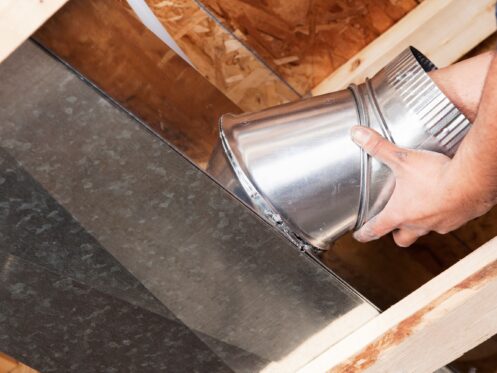Ductwork is an essential component of every central HVAC system, as the ducts are how the heated or cooled air flows throughout the house. Issues like improper ductwork design or air leaks can create major problems for an HVAC system, leading to ineffective operation, high energy bills, and an overall decrease in indoor comfort.
Understanding the Parts of a Ductwork System
Every ductwork system consists of two sides — the supply side and the return air side. When the HVAC system is running, the blower pulls air in through the return air ductwork. Once this air has been heated or cooled, it then gets blown into every part of the house through the supply ductwork.
The incoming air gets pulled in through the return air vents. Older homes and smaller houses often just have one large return air vent. Newer or larger homes may have several return vents. Return vents are almost always located at the base of a wall in a fairly central part of the house, such as the main hallway. This is important for ensuring that the HVAC system properly circulates air throughout the house. These vents are also usually located fairly close to the thermostat.
The return vents are connected to a large return duct, which in turn connects to the furnace and/or AC air handler. The large box located just next to the furnace/air handler is known as the return air plenum, and this is typically where the HVAC air filter is located. However, some HVAC systems instead have an air filter located just behind the grille or grate on each return vent.
The supply side of a ductwork system consists of the supply plenum, the trunk and the branch ducts. The supply plenum is on the opposite side of the furnace/air handler from the return plenum, and this is where the heated/cooled air first exits.
The conditioned air then flows through the trunk, which is a large section of ductwork that extends the length of the house. Several smaller sections of ductwork, known as branch ducts, connect to the trunk and lead to the supply vents in different rooms where the conditioned air flows out. Depending on the size and layout of the house, each branch duct may just supply air to one room or all of the rooms in one part of the house.
Most homes in colder climates like Minnesota have the main part of the HVAC system in the basement or crawl space. In this case, the supply trunk and branch ducts run horizontally underneath the floor on the main level of the house. That means the supply vents on the main level are either located directly on the floor or at the base of the wall, and the supply vents in the basement are located in the ceiling.
The return duct then runs vertically downward from the return vents to where it connects to the return plenum. In warmer climates, the HVAC system is often installed in the attic. In this case, the supply trunk and most of the supply branches are also in the attic.
Types of Ductwork
Ductwork systems can consist of several different types of ducts and be made out of different types of materials. The most common option for residential HVAC systems is rigid, metal ductwork, which is usually made from sheets of stainless steel but can also be made from galvanized steel or aluminum. Stainless steel ductwork is generally considered the gold standard due to its superior strength, durability and longevity. The main concern with galvanized steel ductwork is that it can be prone to rusting when exposed to moisture. Aluminum ductwork performs quite well, but it can be fairly expensive and also get damaged much more easily than steel.
Metal ductwork is custom fabricated in a shop or onsite to meet the specific design and requirements of the building. Each section is then joined together and sealed with either mastic or foil tape to ensure air can’t leak out. Metal ductwork is usually square or rectangular, but smaller branch ducts are sometimes circular instead. This is especially common in situations where there isn’t much room to work with.
Other options for ductwork include flexible ducts, fiberglass duct board and fiberboard ducts. Flexible ductwork is almost only ever used in places where there isn’t sufficient room to run a metal duct. This type of ductwork is made of a long, coiled wire that’s then covered in plastic. While it’s easier to install and can bend or flex to fit any space, it can also get damaged extremely easily, such as by tearing or poking a hole in the plastic and causing an air leak. Flexible ducts also typically create more air resistance, which can lessen the effectiveness of the HVAC system.
Fiberglass duct board provides a higher level of insulation and is great for reducing noise. However, it can also create major indoor air quality issues as a result of the ducts deteriorating and leading to fiberglass circulating around the building. Fiberboard duct also provides a high level of insulation, which can help improve the energy efficiency of an HVAC system. On the other hand, dust and debris collect in fiberboard ducts much more than in the other types. Mold growth can also be a much bigger concern with fiberboard ducts.
The Importance of Keeping Your Ductwork in Good Condition
Ensuring your ductwork is in good condition and free of any issues can make a massive difference in how well your HVAC system performs and how much it costs to heat and cool your house.
Ideally, a ductwork system should be designed with as many long, straight runs and as few bends and turns as possible. This allows air to flow smoothly throughout the house and encounter less resistance.
The more bends there are, the more resistance the air will encounter and the less effectively an HVAC system will move air around the house. Not only can the increased resistance lead to hot and cold spots, but it also makes the HVAC system work harder and can potentially shorten its lifespan or increase the risk of breakdowns.
Ductwork leaks due to damage or improperly sealed joints are also a major concern. Leaks allow air to continually escape, resulting in at least some of the energy the HVAC system uses being wasted. In some cases, leaks can make an HVAC system work 20%-30% less efficiently than it normally should and result in much higher energy bills.
Certain issues are often a sign that there’s an issue with part of your ductwork and you need to get it resealed, repaired or replaced. For instance, weak airflow and hot/cold spots in one room or one part of the house are often a sign of leaks or poor ductwork design. If your ductwork is leaking, you’ll often hear a loud whistling sound caused by air being forced out through a hole, gap or crack.
Another thing to watch out for is ductwork that frequently rattles. This often means a section of ductwork has started to come loose, which can greatly increase the chances of it starting to leak.
For leading heating and cooling services in the Blaine, MN, area, turn to O'Boys Plumbing, Heating & Air. Our team has years of experience in all aspects of HVAC installation, repairs and maintenance. Whether it’s dealing with a ductwork issue or fixing your furnace, you can count on us to perform quality work at a fair price.
If you’re concerned about the ductwork in your home, contact us today for an inspection.

